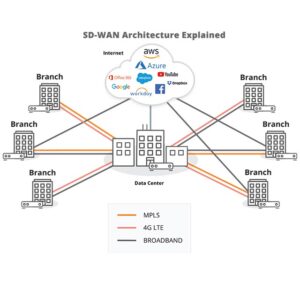 Software-Defined Wide Area Networking (SD-WAN) is a transformative technology that has gained significant traction in recent years. This article will delve into the key concepts, benefits, and challenges associated with SD-WAN.
Software-Defined Wide Area Networking (SD-WAN) is a transformative technology that has gained significant traction in recent years. This article will delve into the key concepts, benefits, and challenges associated with SD-WAN.
Understanding SD-WAN:
1. Definition: SD-WAN is a technology that simplifies the management and operation of a Wide Area Network (WAN) by decoupling the networking hardware from its control mechanism. This is achieved through the use of software-defined networking principles.
2. Core Components:
- Edge Devices: SD-WAN utilizes edge devices, often called SD-WAN appliances, which are deployed at the network’s edges, such as branch offices.
- Controller: A centralized controller manages and oversees the entire network, providing a holistic view and control over the network traffic.
Benefits of SD-WAN:
1. Enhanced Agility: SD-WAN offers unparalleled agility, allowing organizations to adapt their networks quickly to changing business needs. This is particularly crucial in the dynamic landscape of modern business.
2. Cost Efficiency: Traditional WANs can be expensive to operate and maintain. SD-WAN leverages cost-effective internet links and automates traffic routing, resulting in potential cost savings.
3. Improved Performance: SD-WAN optimizes network performance by dynamically choosing the most efficient and reliable path for traffic, leading to enhanced user experience and application performance.
4. Centralized Management: The centralized control provided by SD-WAN simplifies network management, allowing administrators to monitor, configure, and troubleshoot the entire network from a single interface.
Challenges and Considerations:
1. Security Concerns: While SD-WAN brings many benefits, it introduces new security challenges. Organizations must implement robust security measures to protect against potential threats and vulnerabilities.
2. Integration Complexity: Integrating SD-WAN into an existing network infrastructure can be complex. Proper planning and expertise are required to ensure a seamless transition without disruptions.
3. Bandwidth Requirements: Organizations need to carefully assess their bandwidth requirements and choose appropriate SD-WAN solutions to accommodate their specific needs.
Future Trends:
1. Integration with Cloud Services: As businesses increasingly move their applications to the cloud, SD-WAN will continue to evolve to seamlessly integrate with various cloud platforms.
2. AI and Automation: The integration of artificial intelligence (AI) and automation will play a pivotal role in further enhancing the capabilities of SD-WAN, making networks more intelligent and responsive.
3. Security Innovation: Ongoing advancements in security features will be crucial to address the evolving threat landscape, ensuring that SD-WAN remains a secure networking solution.
In conclusion, SD-WAN is a transformative technology that addresses the challenges of traditional WANs, offering enhanced agility, cost efficiency, and improved performance. While it comes with its set of challenges, proper implementation and ongoing innovation will continue to position SD-WAN as a cornerstone in modern network architectures.
















